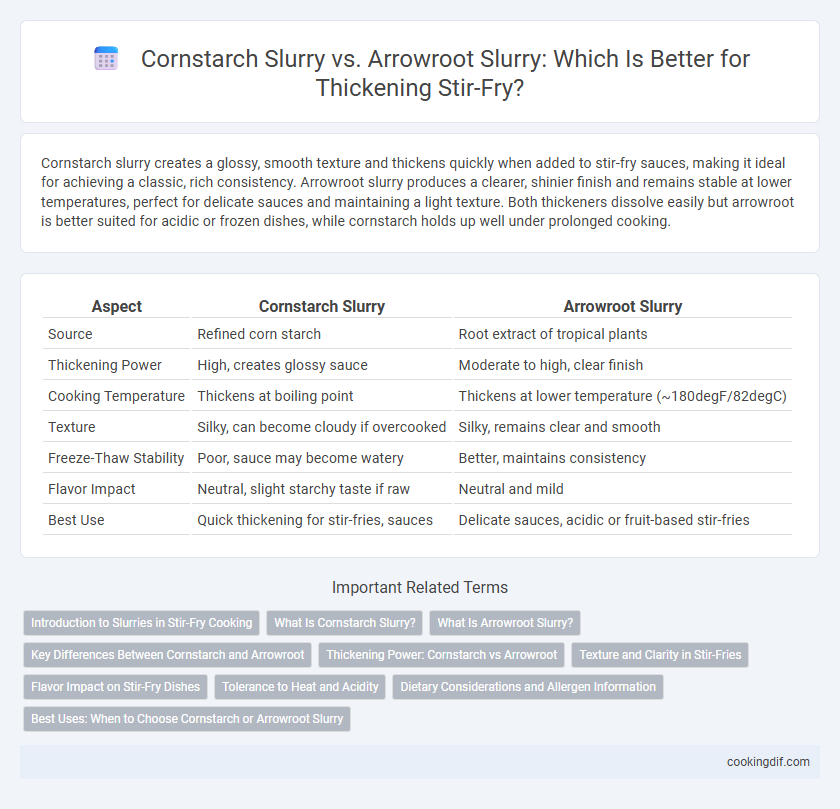Cornstarch slurry creates a glossy, smooth texture and thickens quickly when added to stir-fry sauces, making it ideal for achieving a classic, rich consistency. Arrowroot slurry produces a clearer, shinier finish and remains stable at lower temperatures, perfect for delicate sauces and maintaining a light texture. Both thickeners dissolve easily but arrowroot is better suited for acidic or frozen dishes, while cornstarch holds up well under prolonged cooking.
Table of Comparison
| Aspect | Cornstarch Slurry | Arrowroot Slurry |
|---|---|---|
| Source | Refined corn starch | Root extract of tropical plants |
| Thickening Power | High, creates glossy sauce | Moderate to high, clear finish |
| Cooking Temperature | Thickens at boiling point | Thickens at lower temperature (~180degF/82degC) |
| Texture | Silky, can become cloudy if overcooked | Silky, remains clear and smooth |
| Freeze-Thaw Stability | Poor, sauce may become watery | Better, maintains consistency |
| Flavor Impact | Neutral, slight starchy taste if raw | Neutral and mild |
| Best Use | Quick thickening for stir-fries, sauces | Delicate sauces, acidic or fruit-based stir-fries |
Introduction to Slurries in Stir-Fry Cooking
Cornstarch slurry and arrowroot slurry serve as essential thickeners in stir-fry cooking, providing glossy, smooth sauces without altering flavors. Cornstarch, derived from corn kernels, yields a slightly opaque finish and thickens quickly at high temperatures, ideal for classic Asian sauces. Arrowroot, extracted from tropical plant roots, creates a clearer, more delicate texture, maintaining its consistency even when reheated or paired with acidic ingredients.
What Is Cornstarch Slurry?
Cornstarch slurry is a mixture of cornstarch and cold water used as a thickening agent in stir-fry dishes to create a smooth, glossy sauce. It thickens quickly when added to hot liquids, binding ingredients while maintaining a clear and slightly shiny finish. Preferred for its neutral flavor and strong thickening power, cornstarch slurry enhances texture without altering the original taste of stir-fry sauces.
What Is Arrowroot Slurry?
Arrowroot slurry is a natural thickening agent made by mixing arrowroot powder with cold water, prized for its glossy finish and neutral flavor in stir-fry sauces. Unlike cornstarch slurry, arrowroot creates a clear, shiny sauce that remains stable even when reheated or frozen. It is also highly effective at thickening acidic ingredients, making it ideal for various Asian-inspired stir-fry recipes.
Key Differences Between Cornstarch and Arrowroot
Cornstarch slurry thickens sauces quickly and creates a glossy, slightly opaque finish, while arrowroot slurry yields a clearer, more translucent sauce with a smoother texture. Cornstarch is derived from corn kernels and tends to break down when reheated or exposed to acidic ingredients, whereas arrowroot, extracted from tropical plant roots, remains stable under acidic conditions and reheating. Arrowroot also performs better at lower temperatures and does not clump as easily, making it ideal for delicate stir-fry sauces requiring a light consistency.
Thickening Power: Cornstarch vs Arrowroot
Cornstarch slurry provides a stronger thickening power, often requiring less quantity to achieve a desired viscosity compared to arrowroot slurry. Arrowroot thickens at a lower temperature and produces a clearer, more glossy finish, making it ideal for delicate sauces. Both thickeners perform well in stir-fry sauces, but cornstarch is preferred for thicker, more opaque textures while arrowroot excels in maintaining a shiny, smooth consistency.
Texture and Clarity in Stir-Fries
Cornstarch slurry creates a glossy, thickened texture ideal for rich stir-fry sauces, but it can become cloudy and may thicken further upon cooling. Arrowroot slurry produces a clear, shiny finish with a smooth, gelatinous texture that remains stable when reheated, making it suitable for delicate stir-fry sauces. Both thickeners activate quickly at medium heat, but arrowroot maintains clarity better, while cornstarch offers a slightly thicker consistency.
Flavor Impact on Stir-Fry Dishes
Cornstarch slurry imparts a neutral flavor and creates a glossy, slightly heavier sauce texture in stir-fry dishes, enhancing the overall mouthfeel without altering the dish's taste profile. Arrowroot slurry offers a more subtle thickening effect with a lighter, clearer finish that preserves and highlights the natural flavors of fresh vegetables and proteins. Choosing between cornstarch and arrowroot depends on desired sauce clarity and whether a mild or unobtrusive flavor impact is preferred in the stir-fry.
Tolerance to Heat and Acidity
Cornstarch slurry offers excellent tolerance to high heat, maintaining its thickening properties during prolonged cooking and stir-frying, while arrowroot slurry is sensitive to acidic ingredients and high temperatures, causing it to break down and lose effectiveness. Arrowroot performs best in low to medium heat applications and is ideal for dishes with delicate flavors where a clear, glossy finish is desired. Cornstarch delivers a more robust and stable thickening effect for stir-fries involving intense heat or acidic sauces like soy sauce or vinegar-based marinades.
Dietary Considerations and Allergen Information
Cornstarch slurry is a common thickening agent derived from corn, suitable for gluten-free diets but may cause issues for those with corn allergies. Arrowroot slurry, extracted from the arrowroot plant, is hypoallergenic and easily digestible, making it ideal for sensitive diets and paleo or vegan cooking. Both thickeners work well in stir-fry sauces, but arrowroot slurry offers a clear, glossy finish without corn-related allergens.
Best Uses: When to Choose Cornstarch or Arrowroot Slurry
Cornstarch slurry is best suited for thickening savory dishes like stir-fry sauces due to its strong thickening power and ability to create a glossy finish when heated. Arrowroot slurry works well in recipes requiring a clear, shiny sauce and is ideal for acidic or fruit-based stir-fry sauces because it remains stable at lower temperatures and does not break down as easily. Choose cornstarch for robust, long-cooked sauces and arrowroot for delicate, quick-cooked dishes needing a translucent appearance.
Cornstarch slurry vs Arrowroot slurry for thickening Infographic

 cookingdif.com
cookingdif.com